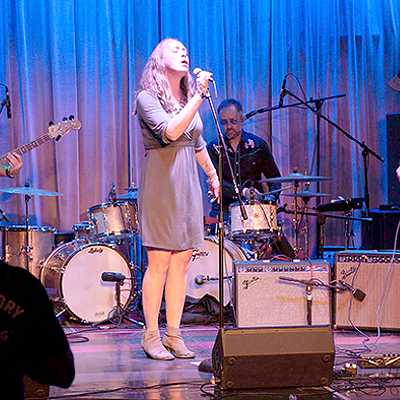"I love her music, and I knew that one day, I would choreograph to her music, but I thought it might be around some of her civil-rights protest songs," he said by telephone last week from Brooklyn, where he and his dancers were taking a two-day respite from a months-long tour.
"Then one day, when we were just about to go to war (in Afghanistan), I just happened to be listening to Nina Simone and this song came on ('Come Ye'). ... And it summed up how I was feeling at the moment with us going to war. ... I needed to remind myself that in a time of war, the destination is still peace."
A highlight of this Saturday's concert, the dance "Come Ye" was workshopped last summer at the American Dance Festival in North Carolina and given its debut in October at the Joyce Theater in New York. A New York Times critic hailed it as a "healing elegy ... a spiritual quest."
Twenty-seven minutes long, divided into five sections and danced by eight, "Come Ye" also includes music by Nigerian composer Fela Kuti.
"It starts off with these calling gestures and people dropping down into prayers a lot," Brown said. "Then it kind of shifts into this dusky, Southern feeling that, for me, takes place in a church." The dancers enact religious devotees who wait and submit to God's will, but "ultimately, I don't think that's what God wants us to do," Brown said. "I think we're in the world, working, as Him."
But this seriously spiritual piece has at least one humorous passage. "Revolution," with the help of a comical Simone tune of the same name, pokes fun at pseudo-revolutionaries who merely dress the part, in, say, Afro hairdos or African garb.
"They're dressed for revolution as opposed to really rolling up their sleeves," Brown said with a laugh.
In the final section, the dance's mood changes again. A three-minute film, aligned with the dancers on stage, depicts real-life people "fighting for change here in the United States, in Africa, in Cuba," Brown said. "Come Ye" becomes a dance "about calling revolutionaries, people who believe in change."
With his intense spirituality and his talent for fusing African movement imaginatively to contemporary dance and ballet, critics have hailed Brown, 37, as the heir to Alvin Ailey, the first great African-American choreographer. (Brown has choreographed a number of new works for the Ailey troupe, which is scheduled to alight on the same Centennial Hall stage the weekend of March 13.) Brown cites a number of influences, but he says he definitely continues to feel a connection to African dance.
"It's the movement vocabulary. You embrace it in the whole African diaspora; there are dance influences from Cuba and Haiti as well as West Africa and the middle Congo. ... That connection will always be there and will tend to increase. In Arizona, we're doing work that is very modern, (but) that has blend. I'm enjoying seeing the range of what do increase."
Raised in New York's tough Bedford-Stuyvesant neighborhood by a mother who believed in his dance future, Brown began choreographing his own work at the age of 19. He studied modern and ballet, and imbibed the rich palette of African dance in the Ivory Coast in visits during several years in the mid-'90s, before the political situation worsened.
Organizers of the American Dance Festival, a premiere showcase of modern dance, early on took an interest in his work.
"I had my first trip to ADF in 1991, as a young choreographer," Brown said. "They had a program there, Young Choreographers and Composers. Then I came back and taught in '92, and I taught there pretty consistently every year there until '96, '97."
As Brown's rep grew and he picked up awards from a Guggenheim to an NEA fellowship, ADF "shifted to commissioning work from the company. They have been very supportive of me and the company."
Brown composed "For You" as a tribute to the late Stephanie Reinhart, for many years a co-director of ADF. Brown danced the solo at Reinhart's memorial service in 2002, and he'll dance it again at Centennial.
"I wanted to do something new that said, 'I love you, and I'm all right that you made this transition,' so that there is a sense of resolution in it and not only grief, but acceptance."
Also on the Centennial Hall program is Brown's "Upside Down," the troupe's signature piece. A work for eight dancers, this one is danced to songs by Oumou Sangare, a singer from Maui, and to more music by Kuti, the Nigerian composer.
"The idea (is) sometimes we run around, thinking we know our destination, we know what we want," Brown said. "But our lives are in chaos; our lives are upside down, and we don't understand why. Sometimes it's a tragedy that happens and brings us back to focus."
Two years ago, when Evidence last played Tucson, the dancers performed excerpts from Brown's "Walking out the Dark," a work originally inspired by his mother's death. This time around, they'll perform different excerpts from the dance, which is 55 minutes long in its entirety. Danced to music by a Cuban band called Cutumba, and a traditional Guinean song, "Sinte," the work for four "is a piece about relationships and individual responsibility. These four individuals have been sent into exile, to contemplate what's in their behavior that's stopping them from getting to someone who needs them or someone who loves them."
Besides working as artistic director of his own company, Brown choreographs all its dances and makes new dances for other troupes. Dayton Contemporary Dance Company premiered a Brown piece in October, and next year, the Ailey company and Philadanco and probably Dance Brasil will debut three others. He fits all this into a busy schedule of touring during the season and teaching at New York University and ADF in the summers.
"I'm trying to balance it out because of the Evidence work schedule," he noted.
And he keeps on performing.
"I still dance, and when I try and make plans not to dance, something happens," he said with a laugh. "I end up dancing anyway."
One thing that happens: He'll run into Chuck Davis, a 60-something who runs an African-American dance ensemble in North Carolina.
"When I see him on the street to say 'hello,' he will start dancing. There I am in the middle of my 'Oh, I'm ready to stop dancing,' and here's this elder dancing toward me." After that, he said, "I try and keep my mouth shut." And dance.














